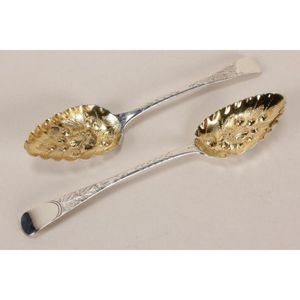George III Berry Spoons with Embossed Gilt Bowl
You must be a subscriber, and be logged in to view price and dealer details.
Subscribe Now to view actual auction price for this item
When you subscribe, you have the option of setting the currency in which to display prices to $Au, $US, $NZ or Stg.
- Embossed / Repousse - Embossing, also known as repousse, is the technique of decorating metal with raised designs, by pressing or beating out the design from the reverse side of the object.It is the opposite of chasing, where the decoration is applied from the front. An embossed or repoussed object may have chasing applied to finish off the design.
- Sterling Silver - Sterling silver is a mixture of 92.5% pure silver and 7.5% of another metal, usually copper. Fine silver is 99.9% pure silver, and is relatively soft and the addition of the very small amount of copper gives the metal enough strength and hardness to be worked into jewellery, decorative and household objects.
- Hallmarks - A mark stamped on articles of precious metals in Britain, since the 14th century, certifying their purity. It derives its name from the Guild Hall of the Goldsmiths' Company, who recieved its Charter in 1327 giving it the power to assay (test the purity) and mark articles of gold and silver.
The hallmark will consist of several marks, including the:
- silver standard mark, indicating the purity of the metal. Sterling silver is .925 pure silver.
- the city mark indicating the city in which it was assayed eg London, Birmingham, York etc.
- the date mark, usually a letter of the alphabet in a particular font and case,
- a duty mark, indicating whether duty had been paid to the crown, and only in use from 1784 to 1890
The piece may include an additional mark, the maker's mark, although not forming part of the hallmark, will be located in the vicinity of the hallmarks.
Sometimes silver plated items will bear faux hallmarks, often confusing those not familiar with silver markings. - Date Letter on Silver - A date letter is a letter or symbol that is used to mark silver and other precious metals to indicate the year in which the piece was made. The date letter system is used by the British hallmarking system and it is a way to verify that a piece of silver is genuine and has been assayed (tested) by an official assay office.
The date letter system has been in use since the 14th century and it changes every year, so it is possible to identify the year in which a piece of silver was made by looking at the date letter. The date letter is usually stamped alongside other hallmarks such as the maker's mark, and the standard mark (indicating the fineness of the metal) on the silver piece. The style of the letters varies depending on the assay office, and the style of the lettering also changes over time. The date letter is usually placed inside a shield shape, sometimes accompanied by other symbols.
The date letter system is not used in all countries, so if a piece of silver does not have a date letter, it does not necessarily mean it is not authentic. The date letter system is not always used for small or insignificant silver items. - George Iii - George III (1738 - 1820) was King of Great Britain and Ireland from 1760 to 1820.
This item has been included into following indexes:
Visually similar items

Pair George III sterling silver berry spoons, hallmarked, London, 1798, R.C ( Richard Crossley), with tapering engraved handles, with gilt shaped bowls, embossed fruit and foliage, total weight 132gm, length 22 cm (2)

Pair of George III sterling silver berry spoons, hallmarked, London, 1771, T.D (Thomas Dealtry), with tapering handles, with engraved crest and scroll work, above gilt bowls embossed with fruit, total weight 142gm, length 21 cm (2)

Pair of George IV sterling silver berry spoons, hallmarked, London, 1821, G.N, with tapering handles, decorated with engraved floral motifs, shaped gilt bowls, embossed with fruit and foliage,total weight 95gm, length 22 cm (2)

Pair of George III sterling silver berry spoons, hallmarked, London, 1791, G.G (George Gray), this maker often overstruck on the work of Bateman, it is possible that this is one such example, with engraved handles, and shaped gilt bowls embossed with fruit
